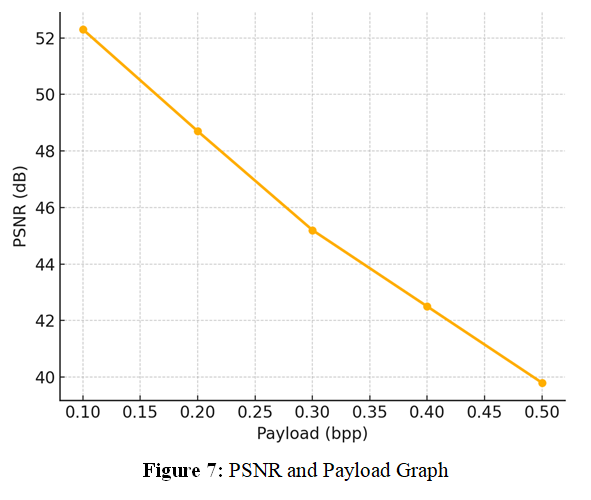Adaptive Steganography Method Based on Localized ACO for Pixel-Level Image Enhancement
DOI:
https://doi.org/10.71229/njemcs.v1i2.4Keywords:
Image Steganography,, Ant Colony Optimization,, Least Significant Bit,, Block-Based Embedding,, PSNR, SSIM.Abstract
With the rapid proliferation of digital communication in critical domains such as healthcare, defense, and finance, ensuring secure and private data transmission has become paramount. Image steganography offers a promising solution by concealing sensitive information within digital images. Among conventional techniques, the Least Significant Bit (LSB) method is widely adopted due to its simplicity and high embedding capacity; however, its deterministic nature renders it vulnerable to visual and statistical steganalysis. This study introduces a novel enhancement to the classical LSB approach by integrating a localized Ant Colony Optimization (ACO) strategy within a block-wise embedding framework. The proposed method segments the host image into non-overlapping 5×5 blocks, where ACO is employed to select optimal embedding pixels. A hybrid fitness function, incorporating Mean Squared Error (MSE), local variance, and pixel energy, guides the selection process to ensure high imperceptibility and robustness. The framework was implemented in Python and validated using standard grayscale and RGB images. We found in experimental results that the proposed method achieves a Peak Signal-to-Noise Ratio (PSNR) of up to 50 dB at a 0.1 bpp payload with maintains a Structural Similarity Index (SSIM) of 0.99, displaying very little visual distortion. The proposed technique that we present in this paper achieves a detection rate of less than 4.81% when evaluated using the StegExpose tool also the developed method achieved a high ROC-AUC score of 0.91, indicating strong resistance to steganography. Furthermore, the suggested ACO-LSB technique can be utilized as a more secure and effective method for hiding secret information in different images which makes it suitable for real-world applications such as hiding metadata in medical images, securing biometric data, and digital watermarking.
References
[1] C. Wang and J. Liu, “GAN-driven image steganography,” Multimedia Tools and Applications, 2022.
[2] T. Xie and Y. He, “Transformer-guided deep steganography,” Pattern Recognition Letters, 2023.
[3] R. Singh and V. Yadav, “CNN-LSTM for image steganography,” IEEE Transactions on Multimedia, 2022.
[4] C.-T. Hsu, “Adaptive steganography using Ant Colony Optimization,” Journal of Information Security and Applications, 2021.
[5] H. S. Manjula, “2-3-3 LSB embedding,” Multimedia Tools and Applications, 2022.
[6] A. Ghasemi and M. Karami, “GA and DWT for steganography,” MTAP, 2020.
[7] Z. Yuan and R. Huang, “Entropy-guided ACO,” SPIC, 2022.
[8] A. Basu and R. Gupta, “Hybrid GA-ACO model,” MTAP, 2020.
[9] M. Ahmed and M. Malik, “SSIM-optimized GAN embedding,” Information Sciences, 2023.
[10] R. Hassan and J. Zhang, “Lightweight steganography,” J. Netw. Comput. Appl., 2022.
[11] Y. Zhang and T. Wang, “ACO in multimedia security,” Applied Soft Computing, 2021.
[12] M. Murugesan and B. Krishnan, “Block-based color embedding,” Multimedia Systems, 2023.
[13] J. Ferreira and M. Costa, “IoT-aware steganography,” FGCS, 2023.
[14] X. Liu and C. Zhou, “Edge-aware embedding,” IVC, 2021.
[15] A. Saleh and M. Alhussein, “Deep-swarmed embedding,” JVCIR, 2023.
[16] M. Rahman and M. Chowdhury, “U-Net for steganography,” Neurocomputing, 2022.
[17] S. Bhatt and P. Mehta, “Real-time ACO-based steganography,” ESWA, 2024.
[18] X. Huang and Z. Wang, “SSIM-based optimization,” SPIC, 2021.
[19] M. Elshamy and M. Shalaby, “Steganography under SSIM metrics,” JVCIR, 2023.
[20] N. Patel and M. Soni, “GAN-Transformer hybrid steganography,” IEEE TCSVT, 2024.

Downloads
Published
Issue
Section
License
Copyright (c) 2025 Al-Noor Journal of Engineering Management and Computer Science

This work is licensed under a Creative Commons Attribution-NonCommercial-ShareAlike 4.0 International License.









